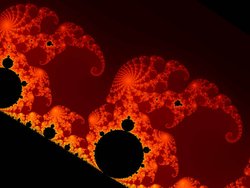Sterling Fractal
|
|
SterlingFractal-GeneratedImage.jpg
Sterling Fractal is a freeware fractal-generating program by Stephen Ferguson, a programmer and mathematics hobbyist. It is extremely important for the aficionado of fractal art to understand that this program is downloadable at no charge, with source code for modifications (see the external link at the bottom of the page).
Most fractal-generating programs require you to pay some money to purchase them before making beautiful fractal images. Sterling Fractal and its cousins, Tierazon, Iterations, et Flarium, originally did not. The programs were given away as public domain, with source code.
Sometime in 2003 or 2004, the author removed free copies of these programs and put them on for-pay download sites. It is still possible to find sites with free copies of the programs (http://faemalia.net/Fractals), but such sites are currently rare.
Focus of Fractal Generators
The image above and to the right is a plot of the standard Mandelbrot Set, however, there are filters in place that add interest to the image. The dark green and pink regions in the upper right are areas that are not part of the set, and traditionally is where much of the colour banding occurs. Notice there is no colour banding, rather, sweeps of colour.
The light blue and green region on the left and lower left of the image are areas that are part of the set, and traditionally the colour there is a single, flat monochrome. However, the colour filters have added banding and sweeps in that range, adding interest to what would otherwise be a very boring segment of the image.
InterstellarDoilies-1024.jpg
In traditional generated images of fractals, the majority of the interest lies only on the boundary between the points that are in a fractal set and the points that are not in the fractal set (with additional interest in how far from being in the set certain points are).
Sterling Fractal, however, is based on the belief that filters and colouring algorithms, rather than the actual fractal boundaries themselves, hold far more interest in creating a visually-appealing representation of the fractal set. The fractal merely serves as a seeding function to the colouring algorithms and filters.
The image to the right is better for understanding what pixels lie within or without the Mandelbrot set due to the less-interesting colouring. The area that's within the set is the completely black region in the lower left, and the completely black "dots" within the red areas. What is not in the set are the coloured reddish regions that fade to black toward the upper right. Programs like Fractint, which use the traditional iterative colouring methods, are much better utilised for understanding and learning about Fractals, whereas programs that have complex filters are better for producing beautiful pieces of art.
External Links
- http://faemalia.net/Fractals - Fractal Galleries, Free Fractal programs, and Fractal Parameter files for re-creating the images on your own computer.

